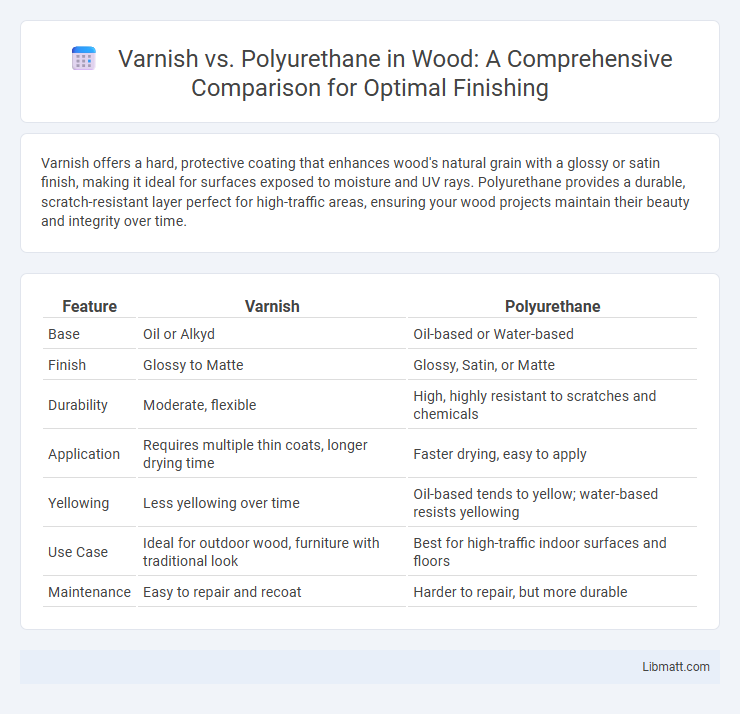Varnish offers a hard, protective coating that enhances wood's natural grain with a glossy or satin finish, making it ideal for surfaces exposed to moisture and UV rays. Polyurethane provides a durable, scratch-resistant layer perfect for high-traffic areas, ensuring your wood projects maintain their beauty and integrity over time.
Table of Comparison
| Feature | Varnish | Polyurethane |
|---|---|---|
| Base | Oil or Alkyd | Oil-based or Water-based |
| Finish | Glossy to Matte | Glossy, Satin, or Matte |
| Durability | Moderate, flexible | High, highly resistant to scratches and chemicals |
| Application | Requires multiple thin coats, longer drying time | Faster drying, easy to apply |
| Yellowing | Less yellowing over time | Oil-based tends to yellow; water-based resists yellowing |
| Use Case | Ideal for outdoor wood, furniture with traditional look | Best for high-traffic indoor surfaces and floors |
| Maintenance | Easy to repair and recoat | Harder to repair, but more durable |
Introduction to Varnish and Polyurethane
Varnish is a transparent, hard protective finish made from resins, oils, and solvents, designed to enhance wood's natural grain and provide moderate durability. Polyurethane, a synthetic resin, offers a tougher, more water-resistant coating often used for floors, furniture, and surfaces that require high protection against scratches and chemicals. Choosing between varnish and polyurethane depends on your project's exposure to wear and environmental factors, with polyurethane generally providing superior durability for heavy-use areas.
What is Varnish?
Varnish is a transparent, hard protective finish used mainly on wood surfaces to enhance durability and appearance. It consists of resins, drying oils, and solvents that form a glossy or matte layer resistant to scratches, heat, and water. Unlike polyurethane, varnish is typically more flexible and allows wood to breathe, making it ideal for outdoor furniture and marine applications.
What is Polyurethane?
Polyurethane is a durable synthetic finish widely used to protect wood surfaces due to its excellent resistance to abrasion, moisture, and chemicals. It forms a hard, clear coating that can be either oil-based or water-based, offering versatility for different applications and finishes. Its strong protective properties make it ideal for high-traffic areas and furniture requiring long-lasting durability.
Key Differences Between Varnish and Polyurethane
Varnish and polyurethane are protective wood finishes with distinct chemical compositions and durability levels; varnish is typically oil-based, offering a glossy finish and excellent UV resistance, while polyurethane is available in both oil- and water-based forms, providing superior toughness and resistance to scratches and chemicals. Varnish enhances the natural wood grain with a warm tone, making it ideal for outdoor furniture, whereas polyurethane creates a harder, more durable surface that suits indoor use and high-traffic areas. Choosing between varnish and polyurethane depends on your project's exposure to elements and the desired finish longevity.
Performance and Durability Comparison
Varnish offers excellent UV resistance and moisture protection, making it ideal for outdoor wood surfaces exposed to harsh weather conditions. Polyurethane provides superior abrasion resistance and chemical durability, which enhances its performance on high-traffic indoor floors and furniture. Both finishes maintain clarity and color retention, but varnish tends to yellow over time, whereas polyurethane remains more stable in appearance.
Application Methods and Ease of Use
Varnish typically requires multiple thin coats applied with a brush or spray, often necessitating sanding between layers for a smooth finish, which can be time-consuming. Polyurethane offers more flexibility in application, available in both water-based and oil-based formulas that can be brushed, sprayed, or wiped on, usually drying faster and requiring fewer coats. Ease of use favors water-based polyurethane for quick projects due to lower odor and faster drying times, while oil-based varnish demands more careful handling and longer curing periods.
Appearance and Finish Options
Varnish offers a glossy, durable finish that enhances the natural grain of wood, making it ideal for traditional, high-sheen looks. Polyurethane provides a versatile range of finishes from satin to high gloss, with excellent resistance to scratches and water, perfect for heavy-use surfaces. Your choice depends on whether you prefer the warm, amber tone of varnish or the clear, protective layer polyurethane delivers.
Suitability for Indoor vs Outdoor Projects
Varnish offers superior protection against UV rays and moisture, making it ideal for outdoor projects exposed to weather elements. Polyurethane provides a durable, abrasion-resistant finish better suited for indoor surfaces subject to heavy wear and tear. Your choice depends on whether the project requires resilience against environmental factors or everyday indoor use.
Pros and Cons of Varnish
Varnish offers excellent durability and a glossy finish that enhances the natural beauty of wood, making it ideal for protecting surfaces from scratches, water, and UV damage. However, varnish can take longer to dry and may yellow over time, affecting the appearance of lighter woods. Your choice depends on whether long-lasting protection or faster application and clearer finish are your priorities.
Pros and Cons of Polyurethane
Polyurethane offers excellent durability and resistance to water, chemicals, and abrasion, making it ideal for high-traffic surfaces and furniture that require long-lasting protection. However, it tends to yellow over time and can emit strong fumes during application, necessitating proper ventilation and careful handling. Your choice should weigh polyurethane's superior hardness against its potential discoloration and environmental concerns.
Varnish vs polyurethane Infographic

 libmatt.com
libmatt.com